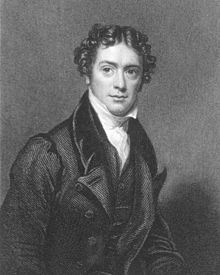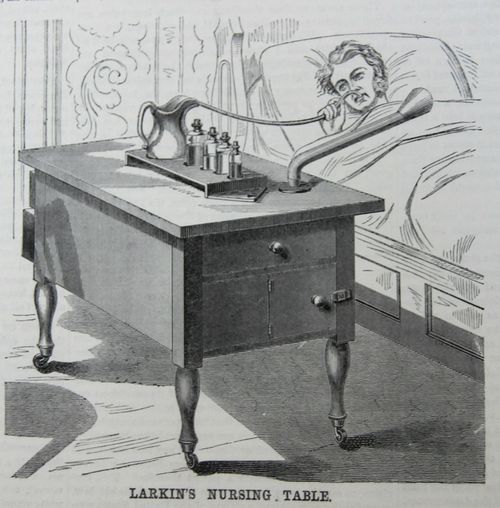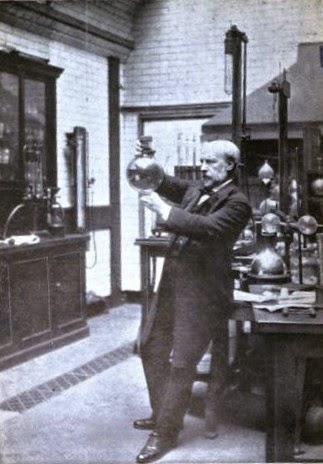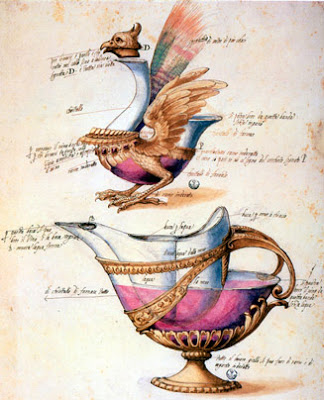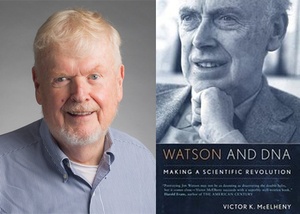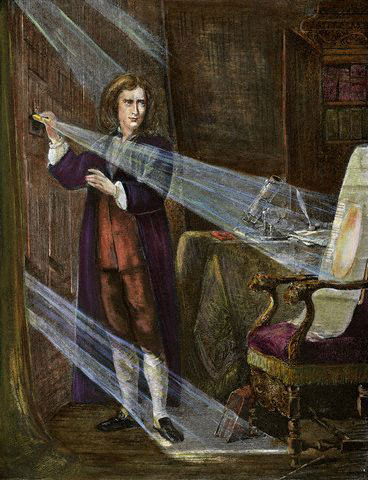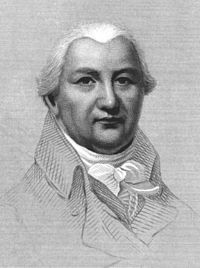Whewell’s Gazette
Your weekly digest of all the best of
Internet history of science, technology and medicine
Editor in Chief: The Ghost of William Whewell
Year 2, Volume #11
Monday 28 September 2015
EDITORIAL:
The world didn’t end on Sunday night so we are back again with your weekly #histSTM links list, Whewell’s Gazette, bringing you all that could be culled from cyberspace on the histories of science technology and medicine during the last seven days.
The reference to the end of the world is of course to Sundays so-called Super-Blood-Moon or to put it somewhat less sensationally and more scientifically the simultaneous occurrence of the moon at perigee in its elliptical orbit around the earth and a lunar eclipse caused by the earth passing between the moon and the sun.
This double astronomical phenomenon illustrates two important developments in the long history of astronomy. The astronomers of Babylon were the first to realise that lunar eclipses follow a predictable arithmetical pattern and were thus able, using an algebraic algorithm, to predict the occurrence of this particular astronomical phenomenon. It would appear that the ancient Greeks were the first to realise that eclipses are the result of the earth casting its shadow onto the moon when both of them and the sun were in the right alignment.
The world would have to wait almost another couple of thousand years before the young English astronomer Jeremiah Horrocks demonstrated in the seventeenth century that the moon also obeyed Kepler’s laws of planetary motion in its orbit around the earth, that is an elliptical orbit with the earth at one focus of the ellipse, thus processing a furthest point, apogee, and a nearest point, perigee, in its orbit.
Put these historical astronomical discoveries together and you have the correct scientific explanation of Sunday’s Super-Blood-Moon. The next one is in 2033 so don’t forget to set the alarm clock.
Quotes of the week:
“It’s time to say it again: I am an atheist but Richard Dawkins does not speak for me”. – Karen James (@kejames)
“Autocorrect just changed Winton Prize into Wino Prize! In vino veritas?” – Thony Christie (@rmathematicus)
“Ultimately the one goal appointed to science may be not to comprehend the nature of things, but to comprehend that it is incomprehensible.” – Emil du Bois-Reymond
“Young men should prove theorems, old men should write books.” – G. H. Hardy h/t @AnalysisFact
“There’s a guy in this coffee shop sitting at a table, not on his phone, not on a laptop, just drinking coffee, like a psychopath”. – Jason Gay (@jasongay)
“There is no branch of mathematics, however abstract, which may not someday be applied to the phenomena of the real world.” – Lobachevsky
“the natural scientist is the man [sic] to decide about wombats and unicorns.”—W. V. O. Quine h/t @GuyLongworth
The Old English word for ‘equinox’ is ’emniht’ (from efen + niht ‘even nights’); so today is the ‘hærfestlice emniht’, autumnal equinox.
After the equinox, as Byrhtferth of Ramsey says, ‘langað seo niht and wanað se dæg’ (the night lengthens and the day wanes). – Eleanor Parker (@ClerkofOxford)
“Occupy yourselves with the study of mathematics. It is the best remedy against the lusts of the flesh.” – Thomas Mann h/t @intmath
“Note to self- if you dig up graves you’re a criminal and creep but if you wait long enough you’re an archaeologist”. – Trver Noah (@Trevornoah)
“And when you read other people’s diaries and mail, you’re a historian”. – Adam Shapiro (@TryingBiology)
How, great,
to, be, a, comma,
and, separate,
one, word, fromma,
nother. – Brian Bilston (@brian_bilston)
“History just burps, and we taste again the raw-onion sandwich it swallowed centuries ago.” – Julian Barnes h/t (@jondresner)
Birthday of the Week:
Michael Faraday born 22 September 1791
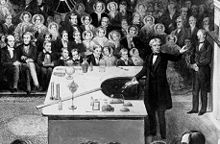
Michael Faraday delivering a Christmas Lecture at the Royal Institution in 1856.
Source: Wikimedia Commons
Yovisto: A Life of Discoveries – the Great Michael Faraday
Brain Pickings: Michael Faraday on Mental Discipline and How to Cure Our Propensity for Self-Deception
Mental Floss: 10 Electrifying Facts for Michael Faraday’s Birthday
Skulls in the Stars: A Cornucopia of Faraday Posts!
PHYSICS, ASTRONOMY & SPACE SCIENCE:
Science Notes: Today in Science History – September 21 – Donald Arthur
KAUST Museum: Explore the Museum > Astronomy and Navigation
Palamar Observatory: Searching the Sky for Dangerous Neighbors: Eleanor Helin and the 18-inch Telescope
The Guardian: Building the Bomb (Multimedia)
Listverse: 10 Incredible Astronomical Instruments That Existed Before Galileo
Yovisto: Hippolyte Fizeau and the Speed of Light
Science Notes: Today in Science History – September 23 – Neptune
The Asian Age: Relativity & comedy of errors
JSTOR Daily: Los Alamos had a Secret Library
Academia: Origins of the “Western” Constellations
A Covent Garden Gilflurt’s Guide to Life: From Augsburg to the Moon: Johann Matthias Hase
The Renaissance Mathematicus: Reaching for the stars
Nature: Archimedes’ legendary sphere brought to life
Voices of the Manhattan Project: Jane Yantis’s Interview
The Local: The German astronomer who found Neptune
Waffles at Noon: Classic Urban Legend: NASA Space Pen
EXPLORATION and CARTOGRAPHY:
Crain’s. How the New York Public Library digitizes its vast map collection
PC Mag: 5 Digital Mapping Projects That Visualize History
The Public Domain Review: Amundsen’s South Pole expedition
MEDICINE & HEALTH:
Remedia: Surgical Devices and Placebo Testing – A Rehearsal
Thomas Morris: Roger ‘two urinals’ Clerk
Center for the History of Medicine: Dawes, Lydia M. Gibson papers, 1926–1959
Yovisto: David Vetter, the Bubble Boy
The Atlantic: The ‘Noble Savage’ Diet
The Sloane Letters Blog: A Friend in Need is a Friend Indeed
Embryo Project: Diethylstilbestrol (DES) in the USA
Ptak Science Books: A Mechanical Night Nurse, 1869
Nursing Clio: Placentophagy Isn’t New, But It Has Changed
Autistica: The Lessons of Autism Research
The Public Domain Review: Gynecological Gymnastics from Outer Space (1895)
Vox: 7 Terrifying medical “treatments” that never caught on
Thomas Morris: A fatal nose job
Yovisto: Typhoid Mary
The Public Domain Review: A Treatise on Adulteration of Food and Culinary Poisons (1820)
Advances in the History of Psychology: Hall’s developmental theory and Haeckel’s recapitulationism
Atlas Obscura: How a Fake Typhus Epidemic Saved a Polish City from the Nazis
Chom News: Priscilla A. Schaffer Papers Now Open
PBS Newshour: Celebrating the life of Alice Hamilton, founding mother of occupational medicine
Thomas Morris: Heal thyself
Conciatore: Top Physician
Center for the History of Medicine: Oral history interview with Margaret Brenman-Gibson
Thomas Morris: The perils of toast
From the hands of quacks: Dieting Deafness Away
ph.ucla.edu: On the Inhalation of the Vapour of Ether in Surgical Operations, 1847 (pdf)
Branch: Matthew Rowlinson, “On the First Medical Blood Transfusion Between Human Subjects 1818”
TECHNOLOGY:
The Verge: Museum of telephones burned to ground in California wildfire
The Guardian: A long history of toilets in Ukraine museum
Yovisto: What a Brick! – The World’s First Cell Phone
Ptak Science Books: The Straight Line Series: Looking Straight Through a Vickers Gun Sight, 1916
Medievalists.net: How to Make Ink in the Middle Ages
Pocket Change: The World’s Oldest Surviving Paper Money
The National Museum of American History: American Watch Company Prototype
Smithsonian.com: The History of the Bar Code
Yovisto: William F. Friedman and the Art of Cryptology
Atlas Obscura: Vacuum Cleaner Museum and Factory Outlet
Open Culture: How French Artists in 1899 Envisioned Life in the Year 2000: Drawing the Future
Conciatore: Stonework
Medievalists.net: Renaissance Robotics: Leonardo da Vinci’s Lost Knight and Enlivened Materiality
Medievalists.net: Friction and Lubrication in Medieval Europe: The Emergence of Olive Oil as a Superior Agent
Smithsonian.com: Can You Guess the Invention Based on These Patent Illustrations?
distillatio: Making blue and green ink
EARTH & LIFE SCIENCES:
BBC: The man who bought Stonehenge – and then gave it away
Embryo Project: Dizhou Tong (1902–1979)
Notches: Tempests and Teapots: Sexual Politics and Tea-Drinking in the Early Modern World
Yovisto: Peter Simon Pallas – A Pioneer in Zoography
Embryo Project: Paul Kammerer (1880–1926)
Embryo Project: The Inheritence of Acquired Characteristics (1924) by Paul Kammerer
Scientific American: Rosetta Stones: Darwin’s Encounter with a Chilean Earthquake
TrowelBlazers: Patty Jo Watson
Leaping Robot: DNA…From Blueprint to Brick
Science League of America: Dixon, Not Darwin
arXiv: Exploration and Exploitation of Victorian Science in Darwin’s Reading Notebooks
Science Notes: Today in Science History – September 25 – Thomas Hunt Morgan
Embryo Project: Thomas Hunt Morgan’s Definition of Regeneration: Morphallaxis and Epimorphosis
BuzzFeed: Inside the Natural History Museum’s Wonderfully Creepy Room of Things in Jars
The Molecular Ecologist: Measuring dispersal rate in Neotropical fishes in units of ‘wallace’
MBL History Project: People of the Lab: Happy Birthday Ivan Pavlov!
Open Democracy: Bacteriology as conspiracy
Open Democracy: It’s the failure to admit failure that fuels conspiracy theories
CHEMISTRY:
Yovisto: James Dewar and the Liquefaction of Gases
Conciatore: Lixivitation
Science Notes: Today in Science History – September 22 – Frederick Soddy
The Chymistry of Isaac Newton: Experiments in Mineral Acids
Science Notes: Today in Science History – September 27 – Adolph Wilhelm Hermann Kolbe
META – HISTORIOGRAPHY, THEORY, RESOURCES and OTHER:
Alun Salt: I clearly don’t understand what an academic review is for
The History Woman’s Blog: Redefining the independent scholar
Thomas Morris: The bird and the bees
teleskopos: What are science museums for?
Social History: New Blog Site
Theos: So, what is science and what is religion and why do you think they clash?
Conciatore: Art and Science
American Science: Announcing the Thomas Kuhn’s “Structure of Scientific Revolutions” Comparison Watch!
Forbes: From Steve Jobs to Oliver Sacks : 12 Scientists and Techies Who Tinkered as Kids
Taming the American Idol: Taylor’s World Pt. 1: Training in Frederick Winslow Taylor’s Social Networks
The Recipes Project: What Recipes Can Teach Us About Reading
Scientific American: Symbiartic: A Science Illustrator’s Legacy

Illustration of Pliciloricus enigmatus by Carolyn Gast, National Museum of Natural History. From a condensed Smithsonian report, New Loricifera from Southeastern United States Coastal Waters
Open Culture: The History of Philosophy Without Any Gaps Podcast, Now at 239 Episodes, Expands into Eastern Philosophy
Nautilus: Five Veteran Scientists Tell Us What Most Surprised Them
ESOTERIC:
BOOK REVIEWS:
History Today: Planck: Driven by Vision, Broken by War
Some Beans: The Value of Precision edited by M. Norton Wise
Science Book a Day: 10 Great Books on the History of Medicine
Literary Hub: The Invention of Nature
NEW BOOKS:
Historiens de la santé: The Last Children’s Plague: Poliomyelitis, Disability, and Twentieth-Century American Culture
Historiens de la santé: Femme Médecin en Algérie – Journal de Dorothée Chellier (1895–1899)
NCSE: The Story of Life in 25 Fossils
ART & EXHIBITIONS
National Museum Cardiff: Reading the Rocks: the Remarkable Maps of William Smith
Museum Boerhaave: Einstein & Friends 19 September 2015–3 January 2016
Slice: The Stars Align at OU for Galileo’s World
ars technica: Science Museum’s Cosmonauts: Birth of the Space Age reviewed
Dundee Science Centre: Nature’s Equations: D’Arcy Thompson and the Beauty of Mathematics Till 25 October 2015
Royal College of Surgeons of Edinburgh: Surgeons Hall Museum: Casualties
The Hunterian: The Kangaroo and the Moose 1 October 2015–21 February 2016
THEATRE AND OPERA:
Berkeley City Club: Ada and the Memory Machine 17 October–22 November 2015
Noël Coward Theatre: Photograph 51 Till 21 November 2015
Royal Opera House: Raven Girl/Connectome
FILMS AND EVENTS:
Bodleian: Ada Lovelace: Celebrating 200 years of a computer visionary 9–10 December 2015
Center for the History of Medicine: Celebrating 10 Years of the Archive for Women in Medicine 3 November 2015
Wellcome Collection: Fred Sanger Lecture: Angely Creager “EAT.DIE.” The Domestication of Carcinogens in the 1980s 4 November 2015
CHF: Brown Bag Lecture: “Making Money Circulate: Chemistry and ‘Governance’ in the Career of Coins in the Early 19th-century Dutch Empire”
Knight Science Journalism at MIT: Book Night Talk with Victor McElheny: Watson and DNA: Making a Scientific Revolution 1 October 2015
Wellcome Library: A celebration of Elizabeth Garrett Anderson and 150 years of medicine 29 September 2015
Discover Medical London: Walking Tour: The Making of Thoroughly Modern Medicine
Bethlem Museum of the Mind: Brain Fag
PAINTING OF THE WEEK:
TELEVISION:
Radio Times: Cosmonauts: How Russia Won the Space Race
BBC Four: Cosmonauts: How Russia Won the Space Race
SLIDE SHOW:
VIDEOS:
The Public Domain Review: Gertie The Dinosaur (1914)
Center for the History of Medicine: Oral history interview with Pricilla Schaffer
Youtube: Alfred Wegener: Science, Exploration, and the Theory of Continental Drift: Book Trailer
Youtube: Albert Einstein (Stock footage/archival footage)
RADIO:
BBC Radio 4: Natural History Heroes: Alfred Russel Wallace
BBC Radio 4: Book of the Week: The White Road
BBC Radio 4: Inside Science: Hiroshima radiation, Anthropocene, Bonobo noises, Physicist Henry Moseley
BBC Radio 4: Computing Britain
BBC Radio 4: In Our Time: Perpetual Motion
BBC Radio 3: Pohl Omniskop X-Ray Machine
PODCASTS:
The Guardian: Why is the scientific revolution still controversial?
Jefferson Public Radio: DNA Decoded: “Life’s Greatest Secret”
Little Atoms: Matthew Cobb & Alex Bellos
ANNOUNCEMENTS:
The Warburg Institute: Rethinking Allegory 30 October 2015
University of Paderborn: International Workshop: Emilie du Châtelet – Laws of Nature/Laws of Morals 23-24 October 2015
IUHMSP: Lausanne: Thérapies dissonantes 30 October 2015
CHoM News: 2015 Fall Event Calendar
Royal Historical Society: Maritime History and Cultural Seminar Series 2015–16
University of Munich: Perspectives for the History of Life Sciences 30 October–1 November 2015
CHoSTM: Working Groups: Physical Sciences: Upcoming Meetings
HSTM Network Ireland: Inaugural Conference Maynooth University 13-14 November 2015
All Souls College, Oxford: Conference: Charles Hutton (1737–1823): being mathematical in the Georgian Period 17–18 December 2015
University of London: Institute of Historical Research: History of Libraries Research Seminars
University of Leeds: CfP: Communication, Correspondence and Transmission in the Early Modern World 12–13 May 2016
University of Edinburgh: CfP: Sixth Integrated History and Philosophy of Science conference (&HPS6) 35 June 2016
LOOKING FOR WORK:
The Beckman Center for the History of Chemistry at the Chemical Heritage Foundation (CHF), an independent research library in Philadelphia, PA: Beckman Fellowships in #histSTM
UCL STS: Part Time Teaching Fellow in STS
Michigan State University: Assistant Professor Philosophy of Science
The German Historical Institute Washington DC: 5 Doctoral Fellowships in the History of Knowledge, Race & Ethnicity, Religion & Religiosity, Family & Kinship, and Migrant Knowledge.
University of Alicante: DOCTORADO EN ESTUDIOS HISTÓRICOS Y SOCIALES SOBRE CIENCIA, MEDICINA Y COMUN
University Miguel Hernández: Programa de Doctorado en Estudios Históricos y Sociales sobre Ciencia, Medicina y Comunicación Cient
University of Valencia: Programa de Doctorado en Estudios Históricos y Sociales sobre Ciencia, Medicina y Comunicación Científica




